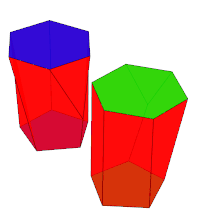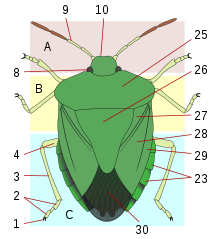

A scutoid is a particular type of geometric solid between two parallel surfaces. The boundary of each of the surfaces (and of all the other parallel surfaces between them) either is a polygon or resembles a polygon, but is not necessarily planar, and the vertices of the two end polygons are joined by either a curve or a Y-shaped connection on at least one of the edges, but not necessarily all of the edges. Scutoids present at least one vertex between these two planes. Scutoids are not necessarily convex, and lateral faces are not necessarily planar, so several scutoids can pack together to fill all the space between the two parallel surfaces. They may be more generally described as a mix between a frustum and a prismatoid.[1][2]

- ^ Gómez-Gálvez, Pedro; Vicente-Munuera, Pablo; Tagua, Antonio; Forja, Cristina; Castro, Ana M.; Letrán, Marta; Valencia-Expósito, Andrea; Grima, Clara; Bermúdez-Gallardo, Marina (27 July 2018). "Scutoids are a geometrical solution to three-dimensional packing of epithelia". Nature Communications. 9 (1): 2960. Bibcode:2018NatCo...9.2960G. doi:10.1038/s41467-018-05376-1. ISSN 2041-1723. PMC 6063940. PMID 30054479.
- ^ Burdick, Alan (30 July 2018). "We Are All Scutoids: A Brand-New Shape, Explained". The New Yorker. Retrieved 3 August 2018.